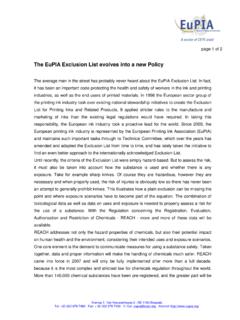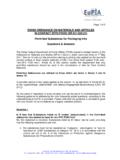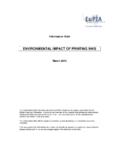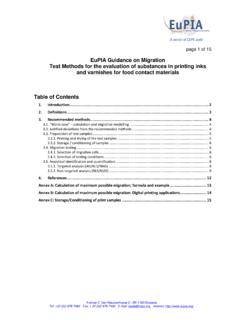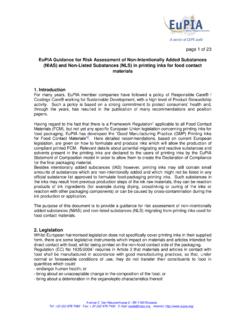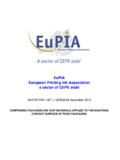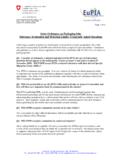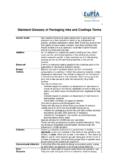Transcription of EXCLUSION POLICY 1ed - EuPIA
1 EXCLUSION POLICY FOR PRINTING INKS AND RELATED PRODUCTS 3rd Edition (replaces 2nd Edition of March 2016) November 2016 EXCLUSION POLICY FOR PRINTING INKS AND RELATED PRODUCTS November 2016 1 Introduction Since 1996 the printing ink industry in Europe has been committed to compliance with a voluntary common list for the EXCLUSION of certain raw materials (substances and mixtures)1 from printing inks and related products. This EXCLUSION list of materials has been based on hazard classification and/or toxicological evidence available at the time, to protect the health of workers within the printing ink industry and customer facilities as well as to ensure the safe use of printed matter. Based on advances in scientific knowledge it has been progressively updated and maintained in force to grant a consistent safety level at all stages of printing ink manufacturing and use.
2 Although this hazard-based voluntary approach has been of considerable benefit to printing ink manufacturers, printers and their customers, it is being increasingly superseded by the management of risks from chemicals under REACH2. In time, all substances will have been assessed and the most hazardous will be subject to appropriate regulatory controls in Europe; however EuPIA s approach has continued value and has been adapted to ensure it remains fit for purpose. Principles The EXCLUSION POLICY concept is applied according to the following principles: 1. The EuPIA EXCLUSION POLICY applies to the manufacture and supply of all types of printing inks and related products, for use in any application and on any substrate. (Note that for certain applications, further requirements may also apply in addition to the EXCLUSION POLICY .) 2. Although the EuPIA EXCLUSION POLICY does not impose any legal obligations, it has the full support of all EuPIA members.
3 New EuPIA members are expected to commit to the EXCLUSION POLICY and will be granted a transitional period of six months to implement it in their operations. Printing ink manufacturers who are not members of EuPIA are also invited and encouraged to apply the criteria of the EXCLUSION POLICY . 3. The EuPIA EXCLUSION POLICY is supplementary to relevant legislation, and any regulatory control over a substance ( an authorisation or restriction under REACH) will take precedence over the following principles. 4. Raw materials excluded by the POLICY , and which must therefore be avoided in the formulation of printing inks, are those substances or mixtures classified in one or more of the CLP hazard classes/categories listed in Group A and Group B on the following page. Such materials are considered to represent a risk to health under normal established and foreseeable conditions of use in the manufacture and application of printing inks.
4 5. Furthermore, the substances in Groups C to G (listed in Annex 1) are excluded for intentional use regardless of whether or not they fall under the hazard criteria of Group A or B as per point 4 above. 6. The majority of raw materials used in printing inks are produced under commercial industrial conditions and may contain unavoidable impurities, mostly in small quantities. As some of these impurities may be subject to the criteria of the EXCLUSION POLICY , every effort is made with the supply chain to ensure that they are at a minimum level. 7. For specific technical and performance reasons it may be necessary, in an individual ink, to use a raw material that contains a substance listed in Annex 1 or classified according to Group A or B. This exception may only be applied where the concentration of the substance in the raw material is below the limits at which the raw material will be classified and labelled as per point 4 above.
5 1 According to the definition set in Article 2 of Regulation (EC) No 1272/2008 on the classification, labelling and packaging of substances and mixtures ( CLP ). 2 Regulation (EC) No 1907/2006 on the registration, evaluation, authorisation and restriction of chemicals EXCLUSION POLICY FOR PRINTING INKS AND RELATED PRODUCTS November 2016 2 A decision to use a raw material according to the first paragraph of point 7 shall be made only: - if no suitable alternative raw materials are available - after an appropriate risk assessment has been carried out on the ink manufacturing process - after a risk assessment has been carried out, in conjunction with the converter, on the application and end use of the printed product. 8. When a raw material currently used becomes included in one of the categories in this EXCLUSION POLICY by reason of re-classification, by default EuPIA members are expected to substitute this material as soon as practicable.
6 A time frame of six months is normally regarded as appropriate. 9. If, after technical investigation, it is found not to be possible to replace a raw material in the short term for a specific application, an exemption from substitution can be granted according to the following rules: a. For hazards listed in Group A, the explicit approval of the EuPIA Technical Committee is required. A list of exemptions approved under this procedure is provided in Annex 2 to this document. b. For hazards listed in Group B (only), it shall be the responsibility of the individual member company to conduct a risk assessment and to demonstrate that safe use is assured (in their own manufacturing, in customers operations and/or in the final printed product as appropriate). 10. Members shall report any use of the exemption procedure in 9a or 9b to the EuPIA Secretariat, who will collate these notifications and report bi-annually to the EuPIA Technical Committee.
7 11. The current criteria of the EXCLUSION POLICY are not retrospective: substances already excluded under previous rules cannot be re-introduced under the above rules. 12. The EuPIA EXCLUSION POLICY , including approved exemptions, will remain under regular review by the Technical Committee and may be amended, where appropriate, in the light of new data on safety, health and environmental matters. EXCLUSION criteria Substances and mixtures classified in the following hazard classes/categories3, shown with their respective hazard statement codes, are excluded as raw materials for the manufacture of printing inks and related products supplied to printers: GROUP A GROUP B Acute Toxicity Cat. 1 & 2 [H300, H310, H330] Acute Toxicity Cat. 3 (inhalation) [H331] Acute Toxicity Cat. 3 (oral, dermal) [H301, H311] Carcinogen or Mutagen Cat. 1A & 1B [H350, H340] Toxic to Reproduction Cat.
8 1A & 1B [H360] (non-threshold substances) Toxic to Reproduction Cat. 1A & 1B [H360] (if threshold exists) STOT Single Exposure Cat. 1 [H370] STOT Repeated Exposure Cat. 1 [H372] 3 Applies both to harmonised classifications contained in CLP Annex VI Table and to self-classifications assigned in accordance with Annex I to the CLP Regulation. EXCLUSION POLICY FOR PRINTING INKS AND RELATED PRODUCTS November 2016 3 Annex 1: substances explicitly excluded for intentional use (irrespective of hazard classification) Group C. Pigment colorants based on and compounds of antimony4, arsenic, cadmium, chromium (VI), lead, mercury, selenium. D. Dye colourants: Auramine (Basic Yellow 2 CI 41000) Chrysoidine (Basic Orange 2 CI 11270) Fuchsine (Basic Violet 14 CI 42510) Induline (Solvent Blue 7 CI 50400) Cresylene Brown (Basic Brown 4 CI 21010) Other soluble azo dyes which can decompose in the body to bio-available carcinogenic aromatic amines of Category 1A and 1B according to the CLP Regulation (EC) No.
9 1272/2008. E. Solvents: 2-Methoxyethanol 2-Ethoxyethanol 2-Methoxyethyl acetate 2-Ethoxyethyl acetate Monochlorobenzene Dichlorobenzene Volatile chlorinated hydrocarbons, such as trichloroethylene, perchloroethylene and methylene chloride Volatile fluorochlorinated hydrocarbons 2-Nitropropane Methanol F. Plasticisers: Chlorinated naphthalenes Chlorinated paraffins Monocresyl phosphate Tricresyl phosphate Monocresyl diphenyl phosphate G. Various compounds: Diaminostilbene and derivatives 2,4-Dimethyl-6-tertiary-butylphenol 4,4 -Bis(dimethylamino)benzophenone (Michler's Ketone) Hexachlorocyclohexane 4 With the exception of non-bio-available pigments in which antimony is a constituent of the crystal lattice and of organic derivatives not classified and labelled as per the EXCLUSION criteria on page 2. EXCLUSION POLICY FOR PRINTING INKS AND RELATED PRODUCTS November 2016 4 Annex 2: exemptions approved by EuPIA Technical Committee under this POLICY 1.
10 Formaldehyde in micro-encapsulation for scent varnishes, provided that the residual formaldehyde content does not exceed w/w in the microcapsules and w/w in the final varnish (determined according to EN ISO 14184-1).
